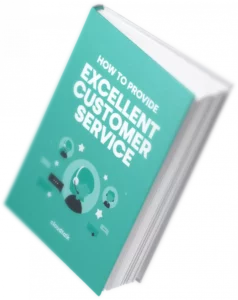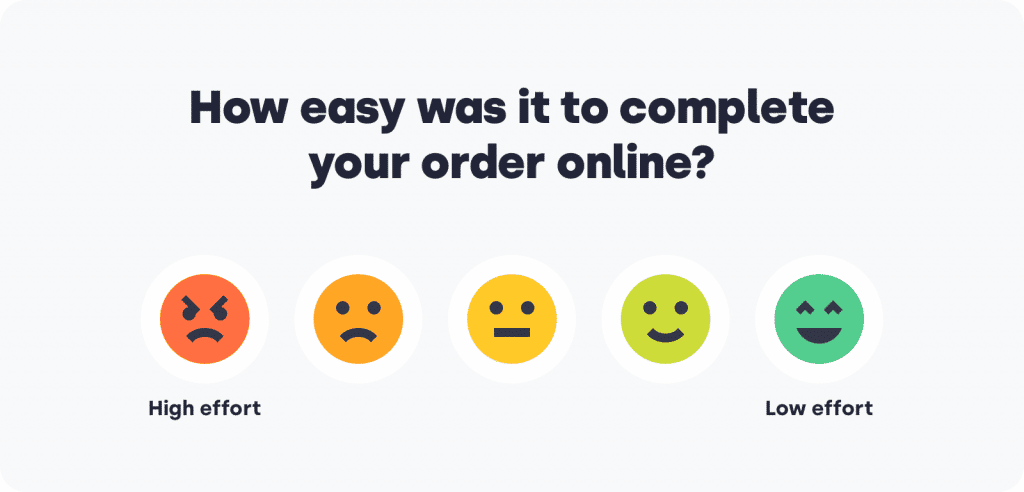Measuring Customer Satisfaction: How To Do It and Why?

Everyone wants satisfied customers. We bet you do, too. Are you doing enough for it? Every day, disappointed clients cost companies a big share of profit. Several studies showed that around 80 % of customers are prone to leave your brand just after one negative experience. In contrast, 72 % of consumers are loyal to those businesses that are famous for their exceptional customer service.
The first step to build a better customer experience is to admit you have room for improvement. The second one is to actually measure a level of your customer satisfaction. Keep reading – we will show you how to do so and, most importantly, why.
Learn how to provide excellent customer service

Why Should You Measure Customer Satisfaction?
The main goal of customer satisfaction measurement is to drive your business directly towards growth. Some may say that KPIs are designed only for managers’ pleasure – to chase better results. Of course, the results are meaningful. But the real reason metrics are introduced is that they are the presentation of the client’s perception of the company.
We will sum all the most important reasons for customer satisfaction measurement in 4 simple points.
#1 Dissatisfied Customers Cost More
There is an important economical aspect of negative customer experience. Whether your client is satisfied with your or not has an impact on both direct and indirect costs.
The direct profit loss is influencing the company’s turnover. Indirect costs increase customers’ complaints and harm their loyalty towards your brand. Around 91 % of clients most likely turn to your competitors after a negative customer experience.
#2 Degree of Satisfaction Determines Your Image
Satisfied customers stay with you – it’s that simple. And happy customers share their happiness with others. So, you not only boost customer retention, but also higher the chance to gain new clients.
On the contrary, when customers are unhappy, they turn away from your brand. You may know it from your own experience. Would you stay loyal to a company that treats you purely? No, you would probably stop giving them profit.
Customer dissatisfaction leads to negative word-to-mouth. People share their bad experiences on various platforms, including social media, where information flows really fast. According to the American Express Survey, on average, a person is prone to tell 9 people about a positive experience, while 16 people about a poor one.
This can seriously damage your brand image, and getting people to forget the unpleasant experience is not an easy task. Especially in the online era.
#3 It’s Easier to Retain Than to Acquire
Getting new clients on your side requires plenty of marketing and prospecting efford and more money. Rather than acquisitioning new clients, you may want to improve your retention. Retaining customers is actually 6 to 7 times more costly than losing them and acquiring new ones.
Further, people who have a positive customer experience with your services are more likely to become loyal not only to the product, but also to your brand. That is called attitudinal brand loyalty. These customers are usually less sensitive to higher prices compared to less loyal clients.
#4 Customer Satisfaction Measurement Helps You Grow
Satisfied customers are key for business growth. By measuring how happy are clients with your products, you gain more insights into what you do well and where you have a space for improvement. You may therefore offer a product or service that is more tailored to your customers’ liking.
Also, customer satisfaction measurement leads to more efficient building of customer relationships.
What Are Customer Satisfaction Measurement Best Practices?
- Make a list of all metrics that could be useful in your organization.
- Learn what information all metrics give you.
- Find customer satisfaction measurement tools that will enable you to start collecting data.
- Gather data over a certain period of time.
- Check which results are poor and why.
- Implement changes in customer service based on your findings.
- Compare new data with the previous period to check if these changes helped.
Now, we will dive deeper into these points in order to gain higher customer satisfaction.
Metrics to Measure Customer Satisfaction
Becoming a skilful driver comes with years of experience. It’s the same with customer satisfaction measurement. You need to find out which metrics fit your business. Also, you should learn what information the given KPIs provide you with. Some of them are more general and show you an overview of the quality of customer service. The other metrics will help you generate ideas on customer service improvement.
Here are 3 most important ones:
#1 Customer Satisfaction Score (CSAT)
Customer satisfaction is the most intuitive score to measure the general level of client satisfaction. The consumers are asked to rate specific factors, like the business quality, purchase process, interactions with customer service reps or even general experience with your brand.
To measure CSAT, customers are asked simple question, such as:
“How would you rate your experience with our XY (for example, customer service)?” It depends on what you want respondents to evaluate.
There are more metrics that you can choose from. Customers may choose from options like:
Very satisfied / Somewhat satisfied / ( sometimes brands also use Neutral) / Somewhat dissatisfied / Very dissatisfied.
You may also use a scale from 1 to 5 or from 1 to 10. It can vary from business to business. Yet, one thing stays the same. The lowest number means the experience is very bad, and the highest that it was very satisfying.
By measuring CSAT, you receive feedback towards the customer satisfaction level of a given service. To get precise insights, you can design the research for each interaction or an important moment of the process.

How To Count CSAT?
Customer Satisfaction Score is calculated by dividing the total positive responses (therefore – very satisfied and somewhat satisfied) by the total number of responses, which you then multiply by 100. This way, you get your CSAT: a percentage of customers who recognize themselves as satisfied.
Generally, a good score is between 75 % and 85 %. if it is lower, you should take some actions to remedy the customer satisfaction level.
Disadvantage of CSAT is that it shows only the emotional feeling of your customer, yet no specific reasons behind. On the other hand, while tracking it in a longer time, it can show you the tendency whether your business improves or not on a long scale.
#2 Net Promoter Score (NPS)
NPS measures the level of customers’ advocacy – an affective and behavioural dimension of customer satisfaction. It shows how likely it is that your client recommends your services to other people.
It stands on a question:
“On a scale of /f.e. 0 to 10/, what is the probability that you would recommend our brand to your friends or colleagues?”
The results divide respondents into three groups – promoters, passives and detractors.
- Rating 9 to 10: Promoters
- Rating 7 to 8: passives
- Rating 6 to 0: detractors
The first group consists of loyal customers, so delighted with the support service that they are willing to recommend it. In turn, destroyers are those clients who criticize the brand and are ready to replace it with another one. Neutral people are rather positive about the brand but not to that level that they wouldn’t consider changing a service provider.
How To Count NPS?
You obtain the NPS by subtracting the percentage of detractors from the percentage of promoters. The scale runs from – 100 % to 100 %.
The lowest number would mean that 100% of clients are brand destroyers.
The opposite result would show that 100% of clients are brand advocates.
Both situations are impossible, of course. The best customer-focused companies achieve the results in between 70 % and 100 %.
The exact range that determines a good or bad result depends on the industry. Yet creators of NPS, consultancy Bain & Company, claim that numbers above 20 are favourable, 50+ is excellent and 80+ means world class services.
When Net Promoter Score is tracked over the long run, your company may measure the value of activities taken up to improve clients’ satisfaction. The higher the NPS is, the more likely it is that people stay with the brand in the long term. Also, the business will generate more profits through recommendations.
Further, NPS shows whether you should be alerted that your business needs a radical change or pleased that you’re doing really well.
#3 Customer Effort Score (CES)
This customer satisfaction measurement is the newest of all 3. It evaluates a level of customer service quality. Simply put, it shows how hard it is to receive information or resolve an issue.
The clients fill in a poll with a scale where, for example, 1 means extremely easy and 5 means extremely difficult. The easier you make it for customers to get information, the more likely it is that they will be satisfied.
How To Count CES?
You simply sum up all individual scores of customers who provided the answers.
The higher the index is, the harder it is to receive help from your company. If it is too hard, you need to discover where the problem is. Is it with an interface? Or perhaps with the customer service reps?
Customer Satisfaction Measurement Tools
Now that you know why to measure customer satisfaction and how, it’s time to discover the means.
The range of today’s customer satisfaction measurement tools is impressive. You have a broad spectrum of possibilities to gather insights and introduce countless, creative improvements.
It’s worth using a few customer satisfaction measurement tools to validate your hypothesis. For example, if you draw some conclusions from one tool, you can confirm your theory with data from other sources. As a result, you will make more informed decisions.
#1 Survey Polls
An online survey poll is the most common tool you can use. Many customer satisfaction metrics, including CSAT, NPS and CES, are based on customer surveys. The easiest option is to send short questions after the interaction with the customer service.
In surveys, you can pose questions like: “How satisfied are you with the service?” or “How difficult was it to resolve your issue?” You can also ask what aspect of your product or service customers enjoy the most. We recommend using mostly open-ended questions /those where respondents have to answer with whole sentences instead of with simple “yes” or “no”/. Yet, close-ended questions can be effective too, because of their briefness. For example, they are ideal for after-call surveys.
Survey enables you to:
- Customize questions in line with popular research methods
- Share the link online
- Conduct a real-time analysis
Best channels for conducting survey:
- Email: You can send a survey to your prospects or leads via email communication.
- Phone: Clients may give you verbal feedback or fill a short post-call survey at the end of the customer support interaction.
- Social media: You can create a poll on your social media page.
- Online reviews: Let people rate your service either directly on your website or on other platforms.
Important points to define before conducting survey:
- The context of the survey: what do you want to measure?
- The channel for administering the questionnaires: mail, phone, email, social networks
- frequency of the survey
- Formulation of the questions: poorly-formulated questions can lead to errors and incorrect interpretation of the results.
Pro tip: Don’t ask redundant questions. A study showed that 66 % of clients believe the most important thing a company can provide is to value their time.
#2 Emotion Analytics
To make the surveying friendlier and more inviting to customers, you should use more advanced emotion analytics. This way, clients may easily rate your customer service on an emotional scale.
This method allows you to:
- Increase the number of clients’ replies, since choosing mood icons instead of the standard scale in a poll feels way more natural.
- Make the surveys more informal.
- Analyze the statistics for each agent and use this knowledge to coach them.
#3 Performance Statistics
First-class customer satisfaction comes with a continuous analysis of the customer service elements. While customer satisfaction surveys and NPS scores show you a general overview of the client’s perception of the services, they don’t answer the question of what leads to poor results.
By analyzing factors that may affect your customer satisfaction, you receive a bigger picture of the clients’ behaviour and frustrations.
Such statistics are generally available in a call center software and show various metrics, for example:
- Average call duration
- Average speed to answer
- Average waiting time
- Maximum wait time
- Average abandoned call rate
#4 Sentiment Analytics
The numbers count. But effective and friendly communication with clients is the foundation of any satisfying results.
Positive opinions about the company’s service may be due to:
- Having a friendly tone of voice
- Being patient
- Using positive language
- Showing understanding and being an active listener
However, with many clients and agents interactions, monitoring all conversations is almost impossible. This is the reason why sentiment analytics is becoming so popular compared to other customer satisfaction measurement tools.
Apart from making surveying more effective, it can generally be used to assess the nature of customer comments in phone calls, text messages, emails, and chat sessions.
Thanks to a sentiment analysis, your business can:
- Gather data for each agent and define who handles clients’ questions most politely.
- Define the most frustrating issues for clients and eliminate them.
- Route more complicated calls to the agents who present higher sentiment scores.
- Create a coaching system where client-friendly agents can pass their knowledge.
- Receive alerts if some conversations are going in the wrong, impolite direction.
Start With Satisfaction Measurement Process
Having such a large pool of metrics and tools, you can form a well-working machine that will drive your business towards growth. To make that happen, you should take care that all elements of the vehicle are working well with one another.
The metrics should be easily available in the tools and comparable in time. The changes in customer service need to be based on validated data. Only then the measurement of customer satisfaction may turn out to be effective. Because in the end, you will be able to make informed decisions.
For example, let’s say that your metrics score is low due to a long waiting time. You can figure out several reasons. Maybe you have to grow your team. Or maybe you need more efficient call center software. The one that automates repetitive tasks and speeds up your processes.
CloudTalk features, such as workflow automation, automatic text messages or skill-based routing, may help just with that. They allow you to save your precious time and invest energy into making your customers happy.
Want to see CloudTalk’s magic?




















